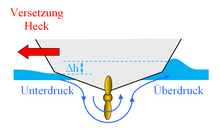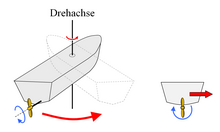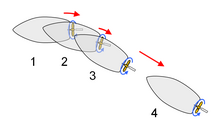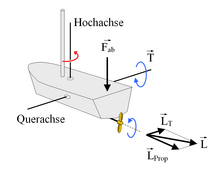Wheel effect
The wheel effect , also known as the screw effect, is the displacement of the stern of a watercraft due to the rotation of the propeller in the water. This effect occurs almost independently of the rudder angle, so that it is also referred to in the specialist literature as the "indirect control effect of the propeller".
The wheel effect is only slightly pronounced and not noticeable when driving ahead. When sailing astern, i.e. H. when reversing, the wheel effect occurs to a greater extent. Depending on the type of ship and the shape of the hull, it can be so strong that the ship moves astern despite the hard counter rudder in an arc against the rudder angle.
With a right-hand propeller, the wheel effect shifts the stern to starboard when traveling ahead , and with a left-hand propeller to port . When traveling astern, a distinction must be made between a fixed propeller, which generates the propeller astern by reversing the direction of rotation of the propeller, and a controllable pitch propeller , which generates the astern by changing the propeller blades. If a fixed propeller is used, the stern is shifted to port with a right-hand propeller and to starboard with a left-hand propeller when sailing astern. If, on the other hand, a controllable pitch propeller is used, the stern is offset in the same direction when driving astern as when driving ahead.
Cause of the wheel effect
Influencing the propeller jet by the ship's hull or rudder blade
The propeller generates the thrust required to propel or brake the ship by accelerating the water backwards or forwards. The accelerated water is called a propeller jet or "rotating water column" and has a more or less strong twist depending on the effect of the propeller .
Drive astern
When sailing astern, the propeller jet hits the hull of the ship. This is shown in the illustration on the right using the example of a right-hand propeller that rotates counterclockwise in reverse. The upper part of the propeller beam hits the starboard (right) side of the stern and exerts a force on the stern in a port (left) direction. A torque is thus generated around the ship's vertical axis and the stern is shifted to port. Or to put it clearly: the water of the propeller jet hitting the starboard side of the stern pushes the stern to port. Conversely, if the propeller is left-handed and rotates clockwise in reverse, the upper part of the propeller beam hits the port side of the stern, so that the stern is shifted to starboard. The cause of the wheel effect when sailing astern is therefore the influence of the propeller jet on the ship's hull, i.e. This means that the propeller jet is disturbed by the ship's hull and exerts a transverse force on it. In other words: the rotating water jet exerts an asymmetrical force on the ship's hull.
However, the wheel effect occurs to different degrees in different ships, with the shape of the hull against which the propeller jet flows, in particular, having a significant influence on the strength of the wheel effect.
To explain this effect, we first consider a propeller jet that is not influenced by a fuselage. The entire propeller jet has a balanced angular momentum. In the case of a right-hand propeller that rotates counterclockwise in reverse, the blade in the upper rotating area (so-called 12 o'clock position) "pushes" the water to the left, the blade in the lower rotating area (so-called 6 o'clock position) to the right . Since about the same amount of water is "shifted" to the left as to the right, the propeller and thus the stern are neither shifted to the right nor to the left.
If this propeller jet is now influenced from above by a ship's hull with a flat, horizontal underside, the rising water accumulates on the ship's hull. The water is deflected almost evenly on both sides and exerts a force on the hull that is almost exclusively directed upwards and hardly contributes to the wheel effect. However, the lower area of the propeller jet remains unaffected by the hull, so that the propeller jet as a whole shifts water to the right and thus shifts the stern to port (left). If, on the other hand, the propeller jet hits a hull with a curved underside, the rising water accumulates on a sloping surface. The result is a force on the ship's hull that is perpendicular to the inclined surface and, corresponding to the inclination of the surface, has a force component in the horizontal direction to the left. On the opposite side of the ship's hull, the propeller "sucks" off the water, creating a vacuum. Together, the two things mean that the stern is shifted to port. In addition, the water shifted to the right in the lower area of the propeller jet also acts here. Several forces acting to port add up, so that the wheel effect is reinforced compared to a ship's hull with a flat underside.
In addition, not only the shape of the ship's hull, but also the position of the propeller under the ship's hull has a decisive influence on the strength of the wheel effect. The wheel effect on ships with saildrive is much less pronounced than on ships with a rigid, straight drive shaft. The reason for this is the distance between the propeller and the ship's vertical axis, around which the ship rotates with the wheel effect. Because the closer the propeller is attached to the ship's vertical axis, the smaller the torque of the propeller jet hitting the ship's hull and the less pronounced the wheel effect is.
In the case of a ship with a rigid, straight drive shaft, the propeller is attached close to the rudder blade and thus far away from the ship's vertical axis. When traveling astern, the propeller jet “pushes” against the hull at a pressure point at a distance equal to the length of the ship's vertical axis, resulting in a torque .
In contrast, on a ship with a saildrive, the propeller is attached closer to the ship's vertical axis than on a ship with a rigid, straight drive shaft. Therefore, when sailing astern, the propeller jet “pushes” against the hull at a pressure point with a distance of the length that is smaller than in the case of the ship with a rigid and straight drive shaft. This means that the torque is also smaller than the torque , the rear end is less offset and the wheel effect is less.
Wheel effect on a ship with a rigid and straight drive shaft ( L drive )
Wheel effect on a ship with saildrive
The rotating water column that is generated by the rotating propeller, however, leads to a further effect that additionally intensifies the wheel effect. There, where the water accumulates on the ship's hull, there is overpressure that pushes the water up the ship's hull, creating a kind of mountain of water here. On the opposite side, where the propeller sucks the water and creates a vacuum, there is a kind of water valley. There is a height difference Δh between the water mountain on one side and the water valley on the other side of the ship's hull, so that the stern slides down from the mountain to the valley.
Drive ahead
The wheel effect also occurs when driving ahead, but it is much less pronounced than when driving astern. On the one hand, when driving ahead, the propeller jet directed astern acts on a much smaller area of the boat hull than when driving backwards due to the propeller arranged “behind”.
Furthermore, the water sucked in by the propeller also has a swirl, but a sucked in water “jet” is significantly less directional than the propeller jet, there is practically no “suction jet”. When driving ahead, significantly less swirling water hits the hull than when driving astern.
On the other hand, the propeller jet directed astern hits the rudder blade when driving ahead. Immediately after coupling the drive shaft, i. H. still without speed ahead, the rudder blade is hit by the strong propeller jet, so that the ship is already maneuverable although it has not yet started sailing. The wheel effect can thus be counteracted immediately by controlling the rudder angle.
When driving ahead, however, not only the shape of the hull, but also the shape of the rudder blade has an influence on the wheel effect. For example, a rudder blade of a half or full swing rudder , as it is mainly used in large ships or yachts, tapers downwards. As a result, the rudder blade opposes the propeller jet in the lower area with a smaller area and thus less resistance. The force of the propeller jet directed to starboard in the case of a right-handed propeller in the upper area of the rudder blade is thus greater than the force directed to port in the lower area of the rudder blade , so that the stern is shifted overall to starboard.
Changeover from driving ahead to driving astern
If the propeller is switched to reverse while driving ahead, the strong wheel effect of driving astern does not start immediately. Rather, the propeller jet, which is now directed forwards, must first overcome the opposite current. Since initially the current outweighs the propeller jet, the weak wheel effect still has an effect on the journey. As soon as the propeller jet outweighs the current, the strong wheel effect of reversing sets in and moves the stern accordingly.
Ship with two propellers
In a ship with two propellers, a left-hand propeller is usually combined with a right-hand propeller. Thus, the wheel effect of both propellers cancels out if both turn forward or both turn backward.
If, on the other hand, one propeller rotates backwards and the other slowly forwards, the wheel effect of both propellers works in the same direction. In the example in the picture on the far right, the port propeller turns backwards and the starboard propeller slowly forwards, so that the ship turns with the stern over starboard without picking up speed. The ship turns on the spot, so that this maneuver is also known as "walking on her wheels".
In a Duoprop , two propellers rotating in opposite directions sit on one axis. This results in two opposing wheel effects that are aligned slightly offset from one another in the longitudinal axis, so that the wheel effect of the two propellers is almost canceled out.
Effect of the wheel effect
A right-hand fixed propeller rotates to the right (clockwise) in forward gear, and to the left (counterclockwise) in reverse. The wheel effect then moves the stern of a ship to starboard (right) when traveling ahead and to port (left) when traveling astern (backward).
In contrast, a left-hand fixed propeller rotates counterclockwise (counterclockwise) in forward gear, and clockwise in reverse. With this type of propeller, the wheel effect moves the stern of the ship to port when traveling ahead and to starboard when traveling astern.
Influence of the wheel effect on a ship with a right-hand propeller when sailing astern
If a backward thrust is given when the ship is stationary and the rudder is in a straight line (position 1), the wheel effect pulls the stern of the ship to port despite the rudder position (position 2). As soon as the ship has started sailing aft, the rudder blade is flowed against by the water “hitting” from the aft (position 3). Only now does the effect of the rudder predominate, the wheel effect only plays a subordinate role, so that the ship follows the rudder position and moves straight astern. (Note: To make it easier to see, positions 1 to 3 are pulled apart in the figure, in reality the ship turns almost on the spot.)
Should z. B. are approached backwards in a narrow canal or a narrow harbor basin , the ship must first be tilted a little. The wheel effect then pulls the ship parallel to the canal or harbor basin and as soon as the ship has started sailing astern, the ship reverses parallel to the canal or harbor basin.
Furthermore, when cornering backwards, the wheel effect influences the turning circle. For example, with a right-hand propeller, a circle over port has a smaller diameter than over starboard. Because if a circle is to be driven backwards over starboard, the wheel effect first turns the stern to port. Only when the ship has started moving does the rudder angle turn the stern to starboard.
Turning the ship with the right-hand propeller in a confined space
If the ship is to be turned on the spot in a confined space, the maneuver "Turning in confined spaces" is used. This maneuver is significantly supported by the wheel effect (see picture):
- 0: Starting position: hard rudder position to starboard (the rudder position is no longer changed until the end of the maneuver at position 6) and give a "strong" push backwards. The wheel effect pulls the stern to port to position 1.
- 2: As soon as the ship wants to start moving backwards, give a thrust forwards until the bow of the ship turns to starboard.
- 3: Now give a "strong" backward thrust until the ship wants to start moving backwards.
- 4: Then give another thrust forwards until the bow of the ship turns to starboard.
(Note: The individual positions 0 to 6 are all in the same place, but for a better overview they are shown apart in the picture)
This change from backward thrust to forward thrust and vice versa is repeated until the ship has reached position 6.
Turning the ship in a confined space over port, i. H. with the rudder angle to port, however, will not lead to success. In this case, the wheel effect and the rudder angle counteract, so that the ship oscillates back and forth, but does not turn.
Lateral laying on a quay wall
Is to the side of a quay wall is applied in a narrow gap, for example, between two vessels, is fed forward drive to the quay wall at an acute angle. The side of the ship into which the wheel effect shifts the stern when driving astern (when stopping) is selected as the landing side (the so-called chocolate side ). With a right-hand propeller, so with the port side, as shown in the adjacent figure.
Shortly before the quay wall, with the ship still slightly inclined, a “powerful” backward thrust is given so that the ship stops (stops) and the wheel effect “pulls” the stern against the quay wall, the ship lies parallel to the quay wall. The wheel effect thus supports the docking maneuver in a particularly advantageous manner.
Erroneous descriptions
Higher density in the depth
A widespread but erroneous view explains the wheel effect with different densities of the water on the propeller. Due to the greater water depth in the lower rotating range of the propeller, there should be a higher density of the water and thus a higher water resistance. At the bottom of the propeller, there is a higher water resistance than at the top, which means that the propeller is “held” in the lower area and rolls off almost as if it were on the ground.
The propeller's water resistance actually depends on the density of the water. However, water is an incompressible liquid and changes its density and thus its volume only insignificantly, even at high pressure. The density of water increases at a pressure of 1 million hPa (approx. 1000 bar), i.e. H. at a depth of 10 km, only by 5%. In the area of the dimensions of ship propellers, the density is therefore practically independent of the water depth. The density and thus the water resistance is therefore the same everywhere on the propeller. H. just as big in the lower turning area as in the upper.
This erroneous description that the propeller "rolls on the ground like a wheel" is often used as a donkey bridge to deduce without much thought in which direction the wheel effect works when the propeller turns clockwise or counterclockwise when driving forwards or backwards. However, the "correct" description of the turning water column can also be used as a donkey bridge, which meets the stern once on port and once on starboard and thus shifts the stern to port or starboard.
Higher pressure in the depth
Another erroneous explanation uses the different hydrostatic pressure instead of the density to explain the wheel effect, since the water pressure is much more dependent on the water depth than the density of the water. In the case of a propeller of a yacht with a diameter of 30 cm, the pressure difference between the outer tip in the upper and the outer tip in the lower rotation range is 30 hPa (approx. 30 mbar). This is clearly noticeable and measurable even with a relatively small propeller.
But even that does not explain the wheel effect, because the resistance that the propeller has to overcome to turn through the water does not depend on the water pressure, but on the density of the water. No matter how big the pressure difference on the propeller, it has no influence on the water resistance and thus does not create the wheel effect.
Influence of the reason
The view is often expressed that the propeller “feels” the proximity of the ground and rolls like a wheel on this “ground proximity”. There is actually a grain of truth here, because the water column set in rotation by the propeller is influenced by the proximity of the bottom. Similar to the ground lake , in which from a certain water depth the underside of the water waves is slowed down by the bottom and the waves break on their upper side, the near bottom brakes the underside of the rotating water column of the propeller. In water waves, this effect occurs from a water depth that corresponds to seven times the wavelength of the water waves. In the case of a water wave with a wavelength of one meter, this means that the water depth is less than seven meters.
However, the wavelength of the water waves is considerably larger than that of the propeller's rotating water column. At 1200 revolutions per minute, i.e. H. 20 revolutions per second, the wavelength of the rotating water column is in the centimeter range, i.e. H. the rotating water column "feels" the bottom only when it has come dangerously close to it from less than a meter. The wheel effect also occurs in very deep waters and also in the middle of the sea, where the bottom is "very far away". The influence of the ground on the rotating water column is thus an effect that contributes to a small extent to the wheel effect, but is not its actual cause.
Change in the angular momentum of rotating parts in the ship
Another hypothesis assumes that the wheel effect occurs when accelerating or releasing the boat engine. Accelerating or releasing the accelerator causes a change in the speed of the drive system, i.e. H. the motor shaft, the drive shaft and the propeller, and thus a change in its angular momentum . But does this result in a torque of the ship around the ship's vertical axis and thus the wheel effect? So is the torque perpendicular to the changing angular momentum ? No, because the change in angular momentum and the torque are the same, i.e. H. especially parallel to each other and not perpendicular to each other. This means that the stern is not shifted either to port or starboard.
But: an increase or decrease in the speed of the boat engine leads to a movement of the boat hull. However, due to the preservation of the angular momentum, this must take place in exactly the opposite direction to the change in speed of the boat engine or the shaft and thus around its longitudinal axis ( roll axis ). If you increase z. B. the speed of a counterclockwise rotating propeller, the ship rotates about its longitudinal axis clockwise, that is, in the opposite direction.
If the helmsman gives gas (filling) or takes the gas off, the ship turns briefly around the ship's longitudinal axis. And so long until the propeller has reached a constant speed again, until the angular momentum no longer changes.
A vivid example of the conservation of angular momentum is a helicopter . In the case of a helicopter, the rotation of the rotor must be compensated so that the fuselage of the helicopter is not set in a rotation that is opposite to the direction of rotation of the rotor. This compensation is usually done by the tail rotor, which prevents the fuselage from rotating. The compensation could also take place by two rotors arranged one above the other, one rotor rotating to the left and one rotor rotating to the right. However, when the rotor is engaged, i.e. when the angular momentum changes in the vertical direction, the helicopter does not rotate about the longitudinal axis of the helicopter, i.e. in the horizontal direction, as should be the case with the aforementioned hypothesis.
The drive system as a gyro
The rotating drive system consisting of the motor shaft, drive shaft and propeller acts like a top that rotates around its axis. If the top is set in rotation about its axis, as soon as its axis is no longer vertical, it also performs a tumbling movement, the so-called precession .
But even if the rotating propulsion system of a ship is viewed as a gyroscope that precession under the influence of an external force, this does not explain the wheel effect.
The illustration opposite shows a ship with its propeller turning clockwise. On the stern of the ship now acts z. B. due to the propeller suction a downward force that leads to a torque about the ship's transverse axis. The angular momentum of the torque and the angular momentum of the propeller add up to a total angular momentum that moves the stern of the ship to starboard. So this would explain the wheel effect. But if the propeller rotates in the opposite direction, the result is a total angular momentum that also shifts the stern of the ship to starboard. However, if the propeller is turning counterclockwise, the wheel effect will shift the stern to port!
See also
literature
- Müller / Krauss: manual for ship command . Volume 2, Part A, 9th edition, Springer Verlag 1988, ISBN 3-540-17939-9 , pp. 110-112.
- Ramon Gliewe (ed.): Seamanship . 26th edition. Delius Klasing Verlag, Bielefeld 2003, ISBN 3-7688-0523-9 , p. 145.
- Paddle wheel . In: Bowline . No. 5, 2001, pp. 64-69.
Web links
Individual evidence
- ^ Müller / Krauss: Handbook for the ship's command . Volume 2, Part A, 9th edition, Springer Verlag 1988, ISBN 3-540-17939-9 , pp. 110-112.

































